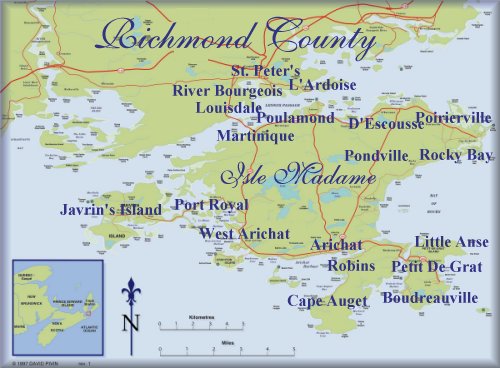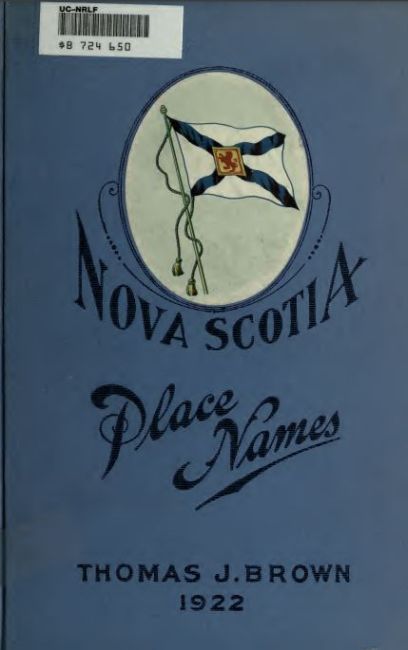
Map of Richmond County with points of interest...
Simplistic map of Nova Scotia, showing relative positions of Louisdale and Halifax.
More detailed map showing Isle Madame and Lennox Passage, and a small portion of the Cape Breton mainland.
ARICHAT -- —The Micmac Indian name "Nerichat" was by transformation brought to Arichat. On some early plans it is found as "Nerichau." West Arichat was at one time named ** Acadiaville," as some of the Acadians after their expulsion from Grand Pre, settled in this place. The Indians also had the name of "Liksake" for Arichat, meaning worn rocks, also **EHksake" meaning "the camping ground "
GRAND ANSE -- —A descriptive French name meaning Big Cove.
ISLE MADAME -- —"My Lady's Isle." Once called "Nericka." Rand gives the Indian name as "Neilksaak." This place was at one time named "Maurepas" by the French in honor of a well-known French statesman of that name. Nicholas Denys at one time referred to the Island as "The Island of St. Marie." In the year 1768 a number of Acadians, who in 1765 had emigrated to St. Pierre and Miquelon, came to Cape Breton, took the oath of allegiance to Great Britain, and settled on Isle Madame.
L'ARDOISE— -- So named by the French, meaning "The Bay of Slate," because of the slate cliffs along the shore. The Indian name for this place was "Moglakachk", meaning "the place of brant or geese."
LOUISDALE— -- The earliest name of this place was Seal Cove; it was afterwards named "Barrasois St. Louis." In 1905 at the suggestion of Mr. J. Nelson Scott, the Postmaster, it was changed by an Act of Parliament to its present name, which retains part of the old name with a local descriptive addition.
RICHMOND COUNTY -- —Named in honor of Charles Lennox, fourth Duke of Richmond, who was Governor General of British North America 1818-1819. Was cut off from Cape Breton County in 1836, and formed into a separate county. The townships of Richmond County are four: Arichat, Lenox, Maitland and Hawkesbury. This county contains 623 square miles.
RIVER BOURGEOIS -- —The Indian name for this place was "Nabigwonchek" meaning a "brig" or "ship," the whole meaning"a brig or ship's place."
ST. PETER'S -- The Indian name was "Baslova-akade."The Portuguese called it "San Pedro." The French in 1713 named it "Port Toulouse," after Comte de Toulouse, the illegitimate son of Louis Quatorze and Madame de Montespan. Denys settled it in 1755, and he named it "St. Pierre," (St. Peter's). The spelling of the Indian name is very similar to that of the Indian name for Cape Traverse in Prince Edward Island, which is "Bouselooa," meaning "to travel by water," and as it was the resting place and portage for the natives in their travels from the lakes to the ocean, it is very likely the same word, or a variation of it. Near here is a mount which in the year 1790 appears in several records as Mount Grenville; there was a redoubt here and eight guns mounted. It was named in honor of Grenville who was in 1790 English Secretary of State.
THIBEAUVILLE -- ——This place received its present name August 1st, 1907. It was named after the majority of its inhabitants, who are named "Thibeau." It was first settled by JacobThibeau about 1836.
